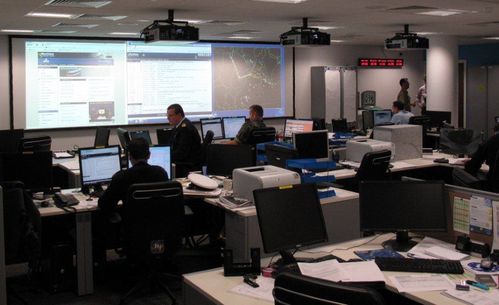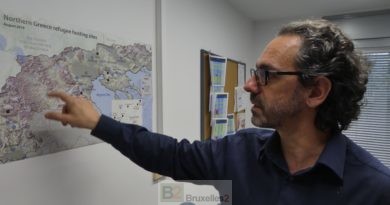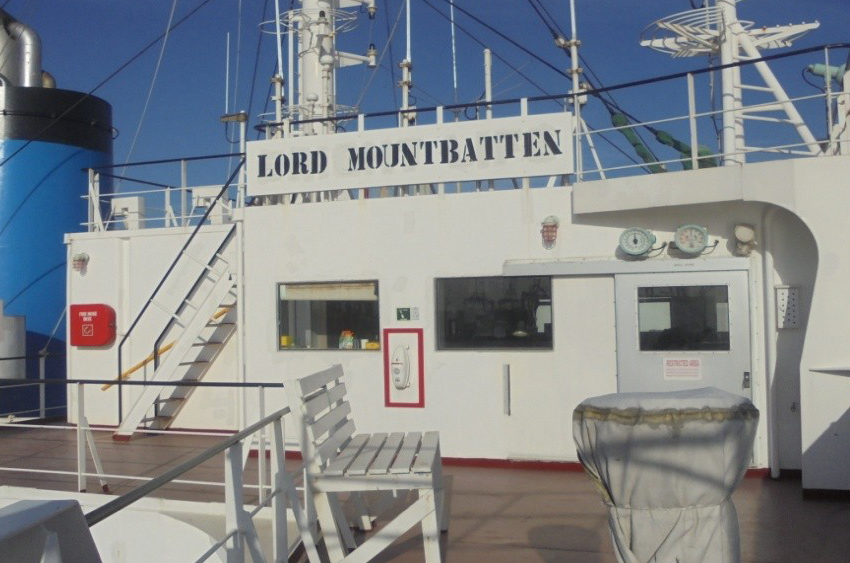Visit to EU Anti-Pirate HQ (Atalanta) in Northwood

Small tour of the owner
On the same site, there are indeed: NATO HQ (in a red brick building), the National Operations Center (mainly for Afghanistan) and the multinational quarter, the latter two housed in a white building, brand new, very bright, and its sky blue walls. The officers of Atalanta have just moved there a few months ago. And Prince Philip, Duke of Edinburgh inaugurated it, on behalf of the Queen, in early May. Outside, work continues; the Northwood base has been under permanent construction for several… years.
The entire “Atalanta” team is housed on the ground floor. On a large plateau, are grouped the main functions of the HQ: planning, policy (Polad) and legal (Legad), media and information, finances and personnel... Below is the commander of the operation and an identical room which allows, if necessary, to carry out simultaneously, a second international operation... or to double the workforce.

The operations room
In one of the corners of the building, the “holy of holies”: the operations management room. A large room, with several desks and the HQ operator's “weapon of war”: the computer. On one of the walls, the means involved: the boats (with photo and short description), the planes (with their callsign, sometimes imaged, "Obelix" can only designate the French Atlantic 2 on duty that day).
But what immediately catches the eye is this wall of images. One of the walls has, in fact, been transformed into a large screen. We can project what is necessary for the decision. Typically, on one side is the “Mercury Cat” (see below), and on the other is streaming TV (like Skynews or CNN). But we can make appear on this improvised screen, what is necessary at the moment.
In the room, a dozen officers are present: as close as possible to the screen, the equivalent of the watch cell on the boat: “battlewatchers” attentively follow the “Chat mercury”; a small intelligence unit, the network administration and the merchant navy officers of the MSCHOA, the registration center for civilian ships.

Civilians here! Yes
And no one is offended by it. Very early on, the soldiers understood the essentials: We cannot do everything alone. Self-defense measures (taken by sailors) are the most important explains the officer on watch. These measures codified in good maritime practices. " In the IRTC corridor, the helicopters can be there in 15 minutes. If we are alerted, in time, that is enough. When they see the helicopter, the pirates flee, most of the time ". But if the alert is given too late, for example " when you hear the pirates behind the sailors, with a gun pointed at the crew, you know it's too late to act ". Mixing civilians with the military is therefore not only desirable, but necessary and useful, every day.
The officer breaks off in his explanation. The Swedish coastguard plane "BlueX" has just spotted a pirate ship. " 4 Pax reported ". " Who goes there? asks the duty officer. " The Victoria responds the battlewatcher. The Spaniards have heard the call and are already heading for the spotted target…
The British as the Framework Nation
At HQ, it was the British who took on the role of “framework nation”. Around 18 people are permanently assigned there for 4 months. They thus provide a good part of the workforce and, at the same time, its stability. While the other nations send personnel for a more limited, variable period, often between 6 and XNUMX months. The first relief ends thus at this moment. Delicate moment for Atalanta who must be able to take over "without loss of memory".
Frame stop on the “mercury cat”
The most original instrument...
The “Mercury cat” is undoubtedly the most original instrument of this operation. It could also serve as a model for future maritime surveillance systems at European level. It's a fairly simple system. originally used by the British and adapted for the needs of the maritime operation. " It's very useful. Previously everyone had their own system. Now everybody's on the same a duty officer tells me.
In its day-to-day functioning, this cat is quite similar to mainstream "cats". It is not "protected" in the military sense of the term, but it is secure. Access is restricted. And only those who have shown their credentials can access it...
« There is no organization that matters. But only available means. Everyone signals their presence according to the principle of goodwill and the spirit that reigns over the sea “, a bit like a Marine VHF. " If a merchant ship is reported under attack, those closest to it spontaneously come to its aid, without discussion continues my guide. " Among sailors, we are among civilized people another commented.
“Joint operations without a chain of command”
The big advantage is thus to be able to bring together all the partners in the fight against piracy, whatever the operation in which they participate – EUNAVFOR, CMF, NATO – or their nationality. Japanese, Chinese, Russians... are also present on the "wire" as are the Seychelles coastguards (cf. combined action with Topaz). The main (land) coordination centers of the allies are linked: the UKMto (the British center for aid to the merchant navy in Dubai), Alindien (the French admiral commanding in the Indian Ocean), the CPCO (the command center armies in Paris)…
In fact, on Mercury, " we do joint operations without a chain of command, without a command order summarizes one of the officers in charge. " It is only based on goodwill. And it works. No one can feel obligated or commanded. And the political questions are evacuated. It is a neutral channel of information ».
However, only the operational players intervene: the military. There is no question of opening the system to merchant ships. These send their info via the MSCHOA or the UKMTO. Similarly, private protection forces do not (normally) have access to it, unlike on-board protection teams of the French army, connected via their PC in the Seychelles.
The role of the OHQ and its means of liaison / coordination
The Role of the OHQ: interface between the political and civil sphere & the operational and military sphere
The job of the OHQ is to liaise with the political chain of command and the other operational partners (civilian as well as military). With NATO this is normally not difficult, just walk across the yard. For Brussels, it's a little more complicated. Remoteness is not automatically an asset.
« Here we manage the medium term - from 2-3 days to a few weeks - in particular relations with the WFP and Amisom ". The tactical command is carried out, directly at sea, by the flagship which carries the FHQ (currently the Swedish, then the French).
The OHQ thus prepares the military directives, gives the impulses and indicates the priorities that the operation commander (the OpCommander) intends to set for the ships. It is there that the directive concerning the treatment of suspected pirate groups, their disarmament and their release (for lack of a host country) was drawn up. The OHQ also manages the arrival of new means, through contact with the EU Military Staff and the General Staff concerned. It also ensures the establishment of new bases or the reconnaissance of sites: where to put the plane? This is how the Portuguese P3 Orion was placed in the Seychelles rather than in Djibouti (where there was no longer enough space).
liaison men
Atalanta has several liaison officers: in Brussels, Bahrain, Djibouti, Mombasa (Kenya).
In Djibouti and Kenya, the delegations of the European Commission have switched, since the beginning of 2010, as EU embassies. And " It's interesting. They get into the political game “says an expert on the file. " And that makes our job easier.”. An Atalanta liaison officer is now in the EU Embassy (previously he was in the French Embassy). In Kenya, there is a liaison officer in Mombasa and in Nairobi, it is the head of delegation who liaises with the authorities.
The role of the liaison officer in Brussels is slightly different. It is a question of maintaining the link with the political authorities, and with the permanent representations, of " solve some problems that may arise ". Sometimes it's about misunderstandings or misunderstandings. " The first time a diplomat in Brussels saw that there were contacts with Iran, he jumped. And an explanation was needed. Because our messages, in military jargon, may seem more consistent to the layman ».
Cooperation with NATO, looking good
Cooperation with NATO and the CMF is in good shape. All my interlocutors reminded me of this, in all tones. We do not feel the tensions and rivalries that may exist at another, more political level, in Brussels. Already, here, everyone is on the same site. And proximity facilitates cooperation. " We're below the political waterline explains an officer. Concretely, " we try to have a common appreciation on the action, the tactics used by the pirates. It's very useful ».

Coordination structured by SHADE
Another more formal element of coordination is the SHADE (like Shared Awareness and Deconfliction Meeting). It brings together the various operation commanders at a regular rate. In general, once a month, in Bahrain, all the heads of operations meet. Not for big talks. Those " meetings are very convenient. They go into the details of the tactics. It's about avoiding being in the same place and at the same time ". SHADE is co-chaired by a representative of EUNAVFOR and CMF.
The coordination function is ensured by the three multinational forces present (EU, NATO, CTF), alternately, both in the corridor and in the Somali basin. The role of the coordinator is not to provide command but to be a " information transmitter ". A “network moderator of sorts”. To him also of detect gaps or possible conflicts ».
The arrival of China
Recently, China proposed to enter the device.“ There is a real will “assures me an expert of the file. " The Chinese seem willing to get heavily involved, by providing the means, in men and ships. They want to show that they are capable at the international and maritime level, of being recognized as a power in equal measure. (...) Their chain of command is quite heavy and rises very quickly to the top. But quite effective it seems. The Chinese “observe first, see how they might act. An implication which does not happen by chance, in the Indian Ocean and in Africa. Favorite land of the Chinese.
« This is certainly part of a more global strategy ". If, on the Chinese side, many signals are positive, on the Indian side, it is more confused. India is also very present in this sea which bears its name. It maintains close relations with the Seychelles (in particular by having renovated the coast guard vessel, the Topaz). Its fishing or trading vessels are among the only ones still to venture into Somali waters to ensure the trade and supply of all kinds of products. Piracy, which until now had remained confined within certain nautical limits, is beginning to approach the Indian coasts firmly. And yet, relations remain if not difficult at least complex. “You never really know how they work. We often have different interlocutors. And usually it gets lost in the meanders of the bureaucracy of the Indian administration”.

Only excluded: Iran
Iran and its ships remain an exception in the maritime coordination effort. His ships and his command do not have access to the "Chat Mercury" nor to SHADE. Relations with Iranian ships are limit to a minimum explains an officer. Even if this “minimum” does not sometimes prevent certain misunderstandings.
All the same, we have the rule of exchanging information of a technical nature: when a helicopter takes off, for example, we call each other to avoid any incident (that another helicopter takes off at the same time, for example, or that there is confusion about our intentions).
But sometimes when a diplomat becomes aware of these exchanges, often transcribed in a laconic way in the weekly report, type " exchange with Iranian ship for sending helicopter », this can give rise to political questions. The word Iran caused a stir in Brussels (see above, on liaison officers).
And... the cafeteria, the ultimate place of coordination
I couldn't complete this tour of the owner without… a tour of the canteen, the cafeteria, the most strategic place on the base. It is here that the latest gossip from the base is exchanged, but also that the latest assessments of the pirates are exchanged or that coordinations are set up, out of frame. We can never say enough how much the canteen and especially the coffee taken together is worth all the plans and coordination committees (well almost :-).
(Nicolas Gros-Verheyde)
(report made at the end of April at Northwood HQ - photo credit: NGV (northwood logo), EUNAVFOR (interior), NATO)


Comments closed.